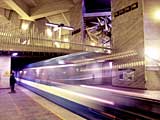3.1
Facilitate travel between different areas of the City by establishing new public transportation services
The City favours the increasing use of public transportation in order to improve the quality of the environment and the quality of life for residents, particularly those without a motor vehicle. In this respect, the Plan proposes a series of actions directed at public transportation networks.
These projects will contribute to providing adequate service for residential, employment and educational areas, as well as to many of the Detailed Planning Areas (see Chapter 4).
Access to Montréal from Laval, Longueuil and the North and South Shores must also be centred on the use of public transportation. From this perspective, the Ville de Montréal favours optimizing the use of existing railway corridors, an initiative which will require modernizing signalling systems, acquiring new rolling stock and double-tracking rail lines in some places. For existing bridges, the City recommends measures that give preferential treatment to public and alternative transit vehicles.
 The proposed public transportation corridors must continue to fit harmoniously into their built surroundings and contribute to revitalizing activities in the areas they serve. In denser areas of the City, light rail and modern tramway systems are appropriate. The STM has identified Avenue du Parc and René-Lévesque, Henri-Bourassa and Pie-IX boulevards as transport corridors with potential for intermediate capacity modes such as articulated buses, modern tramways or light rail. In lower-density areas, minibuses and shared taxi programs should be considered to serve public transit users.
The proposed public transportation corridors must continue to fit harmoniously into their built surroundings and contribute to revitalizing activities in the areas they serve. In denser areas of the City, light rail and modern tramway systems are appropriate. The STM has identified Avenue du Parc and René-Lévesque, Henri-Bourassa and Pie-IX boulevards as transport corridors with potential for intermediate capacity modes such as articulated buses, modern tramways or light rail. In lower-density areas, minibuses and shared taxi programs should be considered to serve public transit users.
The Ville de Montréal also supports universal access to public transportation networks, with facilities that make it easier for all transit users to get around (see Objective 14) and intends to make the public transportation network, particularly the metro, an enjoyable place to be through various efforts including artistic and cultural displays.
The boarding areas of metro and commuter rail stations are designed to ensure a comfortable and safe environment that responds to the needs of riders (see Objective 14). The Plan recommends similar efforts for the transfer points of some of the bus system's most heavily used routes.